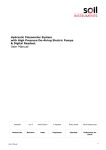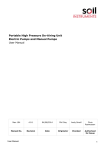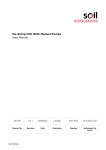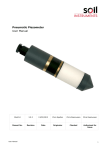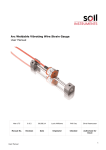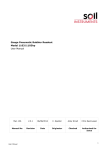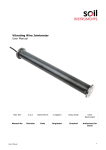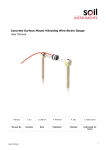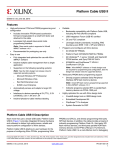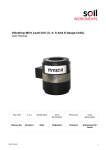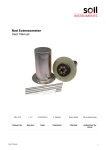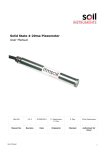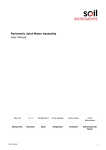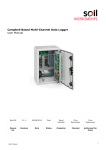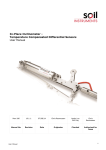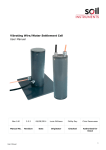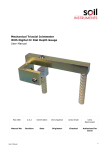Download MAN-082 Hydraulic Piezometer Terminal
Transcript
Hydraulic Piezometer Terminal Equipment With Pressure Transducer & Pressure Logger Readout User Manual Man 082 2.0.2 07/08/14 C.Spalton Andy Small Chris Rasmussen Manual No. Revision Date Originator Checked Authorised for Issue User Manual 1 Contents Section 1 : Foreword ....................................................................................................................................... 4 Section 2 : The Equipment ............................................................................................................................ 5 2.01 2.02 2.03 2.04 2.05 Section 3 : 3.01 3.02 3.03 Section 4 : 4.01 4.02 General Details............................................................................................................................... 5 Terminal Cabinet ........................................................................................................................... 5 Portable De-airing Unit ................................................................................................................. 5 De-aired Water Boiler ................................................................................................................... 5 Portable Readout Unit................................................................................................................... 5 Principle of Operation .............................................................................................................. 6 Installation of the Terminal Cabinet .......................................................................................... 6 Terminating the Piezometer Tubes ............................................................................................ 6 Preparing De-Aired Water ............................................................................................................ 6 The Portable De-Airing Unit ................................................................................................... 7 General Details............................................................................................................................... 7 Preparation and Setting Up ......................................................................................................... 7 Section 5 : Operation and Recharging...................................................................................................... 9 Section 6 : Calculation of De-Airing Pressures ................................................................................... 10 Section 7 : De-Airing Piezometers ........................................................................................................... 13 Section 8 : The Portable Readout Unit ................................................................................................... 14 8.01 Section 9 : 9.01 General details ............................................................................................................................. 14 Care and Maintenance ............................................................................................................ 15 Terminal Cabinet De-Airing Equipment and Readout .......................................................... 15 Section 10 : Memory Loss .............................................................................................................................. 16 Section 11 : Operating Principle ................................................................................................................. 17 11.01 Portable Readout with Integral Transducer ........................................................................... 17 Section 12 : Pressure Logger Model 1019 ............................................................................................... 19 12.01 Introduction .................................................................................................................................. 19 Section 13 : The Equipment .......................................................................................................................... 20 13.01 13.02 13.03 Pressure Logger ........................................................................................................................... 20 Set of Two Flyleads ..................................................................................................................... 20 Battery Charger ........................................................................................................................... 20 Section 14 : Operating Procedures for Pressure Logger ................................................................... 21 14.01 14.02 14.03 14.04 14.05 14.06 14.07 User Interface Overview............................................................................................................. 21 Read Mode .................................................................................................................................... 21 Function Mode .............................................................................................................................. 22 Factory Configuration ................................................................................................................. 23 Log Functions ............................................................................................................................... 23 Configuration Functions ............................................................................................................. 25 System Functions ........................................................................................................................ 25 Section 15 : Charging the Battery .............................................................................................................. 27 15.01 15.02 General Information .................................................................................................................... 27 Charging Procedure ..................................................................................................................... 27 Section 16 : Care and Maintenance of the Logger ............................................................................... 29 Appendix A. User Manual Pressure Logger Model 1019 Front Panel Layout ..................................................... 30 2 Appendix B. User Manual Summary of Basic Keypad Operation ............................................................................ 31 3 Section 1 : Foreword This hydraulic piezometer monitoring system provides a simple and precise set of instruments designed to operate consistently under normal field conditions. Although the components of the system are relatively robust, they will not survive mishandling or neglect. Treat all items with respect and handle with care. Operators should first read and understand the contents of this manual before following closely the various operations described. Failure to do this may result in degraded performance and reduced reliability. Normal maintenance is described in section 12. Soil Instruments Limited has a policy of continual improvement and may alter parts of this document without notice. User Manual 4 Section 2 : The Equipment 2.01 General Details The terminal system described here refers to a simple remote reading and flushing procedure for twin tube hydraulic piezometers. The terminal panel provides a pair of valved manifolds for the two hydraulic lines from the buried piezometer. The manifolds serve two purposes (a) a means of directing de-aired water to each piezometer in the system and (b) providing a switching means to read each piezometer when a portable readout is connected. 2.02 Terminal Cabinet The terminal cabinet comprises a lockable corrosion protected steel enclosure mounted on a concrete plinth. A plastic duct tube enters the base of the cabinet which provides entry of the piezometer tubes. The tubes from each installed piezometer are routed to the terminal manifolds, one tube to the top "SEND MANIFOLD" and one tube to the lower "RETURN MANIFOLD". Each tube is terminated at its appropriate valve at the manifolds. One end of each manifold has a quick- connector to accept flying leads from a portable de-airing unit and readout equipment. A paraffin heater is available to protect the hydraulic piezometer circuit within the terminal cabinet during freezing conditions. 2.03 Portable De-airing Unit The small portable de-airing unit is necessary to initially flush the installed piezometer tubes with prepared de-aired water and to ensure that all entrapped air is removed to provide a hydraulically tight system. It is only necessary to use the de-airing unit after initial flushing if further air migrates into the system from the piezometer tip. This will become apparent from future readings. 2.04 De-aired Water Boiler The de-aired water boiler provides a means of preparing and storing de-aired water and vacuum. The water is transferred to the de-airing unit under controlled conditions to prevent ingress of air. 2.05 Portable Readout Unit The portable readout unit is transported to the installed terminal cabinet and a hydraulic flylead is plugged into one of the terminal manifolds. Each piezometer pressure is monitored by opening the appropriate valve on the manifolds. Two types of readout are available (a) the Digital Pressure Indicator or (b) the Hydraulic Logger. The digital pressure indicator is a simple read only readout where the results have to be manually noted. The hydraulic logger is a state of the art electronic data retrieval unit. Readings are automatically logged and held on dedicated files which can be downloaded at a later date for processing. User Manual 5 Section 3 : Principle of Operation The hydraulic twin tube piezometer is essentially a filter pot installed at the required elevation in boreholes at the base of a trench. Two small bore nylon tubes coated in natural polythene are routed in a trench back to a permanent terminal point. The two nylon tubes are filled with de-aired water to provide a hydraulically tight circuit. Changes in pressure at the piezometer tip are transmitted within the de-aired water to the terminal unit. The piezometer pressure is measured by connecting a portable pressure transducer to the terminal unit. The true piezometric pressure is then calculated taking account of the installed levels. 3.01 Installation of the Terminal Cabinet The terminal cabinet is installed onto a pre-cast concrete plinth in a vertical position above the inlet duct through which the piezometer tubes pass. The cabinet is placed onto rag bolts and secured by nuts and washers from inside the cabinet. Timber formwork is supplied with each cabinet to assist casting of the concrete plinth. 3.02 Terminating the Piezometer Tubes The piezometer tubes are prepared by stripping sufficient polythene sheath to allow each nylon tube to connect with the appropriate pair of valves on the two manifolds. 3.03 Preparing De-Aired Water Up to 50 litres of de-aired water can be prepared in the boiler at one filling. An immersion heater coil heats the water to boiling thus expelling any air or gases in solution. By sealing the boiler and allowing it to cool, the steam and water vapour above the water condenses thus creating a partial vacuum inside the boiler. This prevents further solution of air or gases. Remove the central filler-cap using the special spanner provided. Open Valves V and S. Pour in clean water to within 100mm of the top. Connect the electrical cable to a suitable mains supply (either 10V or 230V as indicated on the immersion heater coil cover). Switch on at the mains. Bring to the boil and allow to boil for fifteen minutes. Switch off at the mains supply and unplug. Close Valves V and S replace the central filler-cap. Allow to cool. WARNING: Although the cap is fitted with a pressure relief valve, never boil with the filler-cap on. IMPORTANT: With a partial vacuum inside the boiler, never open Valve S before opening Valve V, as this will draw air into the de-aired water. SAFETY REQUIREMENTS: The 4 psi Pressure Relief Valve in the centre of filler-cap must be checked at intervals not exceeding 12 months by a competent person. User Manual 6 Section 4 : The Portable De-Airing Unit 4.01 General Details The de-airing unit consists essentially of pressure, supply and return tanks (A, B and C) and gauges to measure water pressure and vacuum during circulation of de-aired water. All these components are mounted on a frame complete with valves and connecting pipework. Pressure and vacuum pumps are used to operate the equipment. Pressure is applied to the de-aired water in supply tank B by forcing water from the pressure tank A into the bladder in B. Water from the supply tank may then be circulated through the terminal manifolds and piezometer tubes back to the return tank C. The volume changes measured in both the return and pressure tanks indicate the quantity of water circulated through the system. The object is to completely replace the water in the piezometer tubes with freshly de-aired water. The equipment has been fully tested to the operating pressure and under vacuum before despatch. However, it is possible that movements of the panel during transit may disturb the cylinders, pipework or valves sufficiently to cause leaks when the equipment is operated. If any leaks are observed during operation they should be eliminated by gently tightening the appropriate component. Never modify the arrangement without the full written approval of Soil Instruments, as unauthorised modifications may bypass the safety system. INFORMTION: It is advisable to drain water from the equipment during cold weather to prevent damage to the cylinders due to freezing. Place the vacuum pump to the right of the unit, the pressure pump to the left-hand side. The pressure pump connects to the Schrader fittings on Valve K. 4.02 Preparation and Setting Up It is essential to operate the valves in the order stated. Initially all the valves should be closed. Completely evacuate the bladder and partly fill the pressure tank A with clean water. Attach the vacuum pump with the hose supplied to Valve E. Open Valves G and E and apply vacuum until the bladder is completely evacuated. Close all valves. Immerse one end of the red rubber tube into a container of clean water and attach the other end to Valve J at the base of the pressure tank A. Open Valves J and E and operate the vacuum pump drawing the water into A. When this tank is seven-eighths full close Valves J and E. Remove the hose from E, open Valve E to release the vacuum, and then close. INFORMTION: Do not allow water to be drawn back to the vacuum pump. Prepare some de-aired water in the de-airing boiler, allowing it to cool as described earlier. Connect Valve S on the boiler to Valve M on the tank C using a length of black rubber hose. Attach the vacuum pump to Valve I, open valves I and M and release the vacuum from the boiler by opening slowly Valve V (on the boiler). Open Valve S and by operating the vacuum pump draw the de-aired water into tank C until it is three-quarters full. Close Valves M and I. Remove the black vacuum hose and open Valve I to release the vacuum. Open Valves G and L, attach the vacuum hose to G and draw the de-aired water from tank C into tank B by operating the vacuum pump until tank C is only one-eighth full. Close all valves. To fill B completely it is User Manual 7 necessary to repeat the operation but only half-filling C with de-aired water. When tank B is almost full close all valves. Remove the vacuum hose from G. Open Valve K and operate the pressure pump to bring the pressure in tank A to 5-10mH20. Open Valve N and gently open Valve G thereby inflating the bladder, displacing the de-aired water in B and forcing out any remaining air. (If the air were to be removed by applying a vacuum at G there is a risk of damaging the vacuum pump by drawing water into it). Any bubbles of air that cling to the rubber bladder and walls of the tank B should be dislodged by slapping the sides of the tank until they rise and accumulate under valve G. They may then be removed with pressure in tank A and momentarily opening Valve G. It is important that cylinder B is completely filled with de-aired water and all air excluded. Release pressure from tank A by opening Valve E, and close all valves. Attach the black vacuum hose to E, open Valves E, L and I and by evacuating tank A, water is drawn from inside the bladder to tank A, thus drawing de-aired water from tank C into tank B. When the bladder is fully deflated tank A will again be seven-eighths full of water. Close Valves E, L and I. Remove the vacuum hose from E and release the vacuum in tank A by opening E. Close all valves. Open Valves I and M to drain the water from tank C. Close all valves. The panel is now fully charged with de-aired water and ready for operation. User Manual 8 Section 5 : Operation and Recharging Attach the black vacuum hose to Valve I. Open Valve K. Operate the pressure pump until the desired pressure is reached in tank A, as indicated by the pressure gauge. Having calculated the optimum de-airing pressures, if a vacuum is required on the return side open Valve I and operate the vacuum pump until the desired vacuum is reached as indicated by the vacuum gauge. Pressurised de-aired water from the supply tank B may now be introduced into the terminal 'SEND' manifold by connecting the flylead from Valve P. The flylead from Valve V is connected to the terminal 'RETURN' manifold. INFORMTION: In certain circumstances no pressure may be required in tank A, in which case close tank K and vent tank A to atmosphere by opening valve E. During operation of the unit the bladder in tank B should not be allowed to distend to more than three-quarters of the volume of the tank. At this point it is necessary to recharge with de-aired water as follows: Close Valves P and V to isolate the manifolds from the de-airing unit. Open Valves E and I to release the pressure and vacuum from the tanks, as indicated by zero reading on the gauges. Close all valves. Drain tank C by opening valves I and M. Attach the black vacuum hose to valve I and the de-aired water supply to valve M. Operate the vacuum pump and draw de-aired water into tank C until three-quarters full. Close Valves M and I. Continue as in sections 6.1.8 and 6.1.9 ensuring that the water in tank C does not empty while being drawn into tank B (avoid drawing air into tank B). User Manual 9 Section 6 : Calculation of De-Airing Pressures Consider a piezometer tip in the soil during the de-airing process as follows: u = pore pressure in the fill at the tip. p = pressure on the pressure side of the de-airing apparatus. v = pressure on the vacuum side of the de-airing apparatus. h = difference in head between the tip and the pressure and vacuum gauges on the de-airing apparatus. fAB and fBC = friction losses in the piezometer tubes. All pressures are measured with respect to atmospheric pressure. For Equilibrium:p = h + u + fAB v = h + u - fBD Since AB = BC and if no water flows in or out of the tip the velocity will be the same throughout the system then fAB = fBC p 2(h + u) – v = In a piezometer installation h is known, v can be maintained at a known value, and u for each tip can be estimated using previous pore pressure readings. In this way p can be calculated for each piezometer and de-airing carried out at the appropriate pressure. If the piezometer lies below the readout point, the term h, the difference in head between the tip and pressure and vacuum gauges on the de-airing apparatus, changes sign and becomes negative. When a piezometer has accumulated a lot of air, care should be taken to apply sufficient pressure to drive water at least as far as the tip before applying a vacuum to the other lead, as friction loss in the return tube carrying air is much less than in one carrying water, and air will be drawn in through the tip from the fill. Example 1 User Manual 10 Where p = 2 (h + u) - v p = 2 (10 + 5) - v p = 30 - v v = 0 p = 30 mH20 v = -5 mH20 p = 35 mH20 for v = -10 mH20 for p = 40 mH20 for User Manual 11 Example 2 for for for User Manual p = 2 (h + u) - v p = 2 (-7 + 4) - v p = -6 - v v = 0 p = -6 mH20 v = -5 mH20 p = -1 mH20 v = -10 mH20 p = 4 mH20 12 Section 7 : De-Airing Piezometers To de-air each piezometer in turn calculate the de-airing pressures and the volume of water required to fill the two nylon tubes to the piezometer. Circulate de-aired water at the calculated pressure through the piezometer tubing, measuring the amount on the graduated scale of the pressure tank of the de-airing unit. Circulate water until no more air bubbles are seen to be returning through the nylon tube, checking that the volume of water returning corresponds to the volume leaving the de-airing unit. Tubing 2W2.1 used for de-airing lines has a volume 66 cc per 100m. Each piezometer has 'FLOW' and 'RETURN' lines. User Manual 13 Section 8 : The Portable Readout Unit 8.01 General details The readout can be either a simple read only unit to a data logger system. Both units have a transducer box attached to them in the form of a small enclosure which houses them electric pressure transducer and hydraulic circuitry. Before use the transducer box has to be primed with de-aired water. Priming needs only to be carried out once with possible occasional topping-up or flushing/re-priming. To carry out initial priming first switch the readout on and observe the digital display is stable. Several minutes may be required for the display and electronics to stabilise. Connect the flying nylon lead from the transducer box to the quick connect on the 'SEND' manifold at the terminal cabinet. With the portable de-airing unit prepared as discussed at section 6. Connect the nylon flylead from Valve P to the lower 'RETURN' manifold quick connect. Check all valves on the de-airing unit and terminal cabinet are set in the off position. Open Valve 1 and 2 on the 'SEND' and 'RETURN' manifolds and set the small valve on the readout/transducer box to 'BLEED & CAL' position. Using foot pressure pump connected to Valve K on the de-airing unit and with Valve K open, slowly pressurise cylinder A to approximately 2 to 3 metres head of water on the pressure gauge. Open Valves N and P on the de-airing unit. De-aired water will flow through the lower manifold into the top manifold via the loop between Valve 1 and 2 and on through the nylon flylead connected at the quick connect to the transducer box where it will be observed that the level of water in the sight window will be rising. When the water level is coincident with the 'DATUM LINE' operate Valve X on the transducer box to 'READ’ position. Close Valve P on the de-airing unit and disconnect nylon flyleads from the top and bottom manifolds of the terminal cabinet. To establish zero reading on the transducer box and readout display operate Valve X to 'READ' position. Check that the water level at the sight window is on 'DATUM LEVEL'. (If not adjust level by removing or adding small amount of de-aired water with s syringe through the air bleed cap). When satisfied that water level is correct, check readout display and adjust 'SET ZERO' screw with screwdriver until zero is shown on the readout. The unit is now ready for taking readings. User Manual 14 Section 9 : Care and Maintenance 9.01 Terminal Cabinet De-Airing Equipment and Readout Since the Hydraulic piezometer system employs water as the pressure sensing medium it is essential that the equipment is adequately protected against freezing in severe cold weather conditions. The terminal cabinet must have the small paraffin heater filled and operating. Ensure that the flame of the heater is not too high to cause smoking. Ventilation is incorporated into the cabinet via two louvre panels which provide sufficient oxygen to support the heater. A full heater should operate satisfactorily for approximately 3 days. It is therefore essential during freezing conditions to check the paraffin level at suitable periods. If the de-airing unit or de-aired water boiler are to be stored in areas where freezing is likely, both units must be emptied. Keep the foot pumps in a clean condition, preventing water from being drawn in during use. Should the pump performance deteriorate it is likely that water has affected the internal leather cup washer. The pump will require strip-down, cleaning and drying and the cup washer re-oiling with light mineral oil. The readout is a sensitive, precise unit and must always be treated with reasonable care. Irreparable damage will be caused to the electric transducer if allowed to freeze. It is therefore important to protect the unit from freezing at all times when not in use. Check all pipework, valves etc for leaks at regular intervals and keep connection clean. Always replace dust caps back onto quick connectors after use. Wipe down the de-airing unit cylinders and frame with dry cloth after use. Regularly check the de-aired water boiler safety relief valve and ensure that the valves are never obstructed. Regular electrical tests must be carried out on the immersion heater by a qualified electrician. User Manual 15 Section 10 : Memory Loss The CMOS ram in SIL portable loggers is maintained when the logger is turned off by the main rechargeable battery, or, if this battery becomes exhausted, by a small on board back-up battery. From a fully charged state these two batteries will maintain the logger’s memory, including its calibration values for several months. Therefore to ensure that calibration constants and data are not lost we recommend that the logger is recharged once a month, even when not in use. User Manual 16 Section 11 : 11.01 Operating Principle Portable Readout with Integral Transducer Prior To Site Visit a) Pressure Indicator “Zeroed” at Datum Level. b) Pressure “HT” is applied to check the indicator calibration prior to site visit. On Site User Manual 17 c) Pore Pressure at the Tip is equal to:(Datum Elevation plus Indicator Reading “Hp”) minus Tip Elevation. or Pore Pressure at the Tip is equal to:“HD” + Indicator reading “Hp”. d) If the Piezometer is installed above the transducer datum then the value of “H D” will be negative. Example 1 Example 2 when Piezometer is below transducer when Piezometer is above transducer datum. datum. If “HD” - 11m. If “HD” = 3.0m. and reading on the indicator is and reading on the indicator is -2.0m then P.W.P. = 11 + (-2.0) -2.0m then P.W.P. = -3.0m + (-2.0) = 9mH20). User Manual = -5.0mH20. 18 Section 12 : 12.01 Pressure Logger Model 1019 Introduction The Pressure Logger in an intelligent, battery powered, portable logger/reader, utilising the very latest 16 BIT microprocessor technology and support circuitry. The CMOS design incorporates sleep modes to reduce power consumption and a large memory address space to minimise constraints on both program and data storage. Features include: a) Continuous display of measured pressure and display and storage of measured pressure. b) Display of readings using pressure units in BAR, kg/cm2, KN/m2, mH20, ft H20, mHg, psi, mPa, kPa and user defined. c) Configuration information can be entered to control the storage of measured pressures. When the transducer box is fitted, range is specified by the user at the time of purchase. d) Facilities for storing up to 12000 pressure measurements in the form of a Log (Log entries are battery backed). e) Each pressure measurement in the Log has the following stored information: i) Channel number ii) The stored pressure value in engineering units iii) The date and time stamp f) Readings are stored in the Log with the most recent one at the top. If more than 12000 measurements are saved then the earliest saved measurement(s) are lost. g) Facilities for dumping the contents of the Log via an RS-232-C serial port. User Manual 19 Section 13 : 13.01 The Equipment Pressure Logger Housed in an epoxy painted lightweight steel case with hinged, sealed lid and carrying handle. The Logger incorporates a sealed membrane panel with tactile keyboard, 2 line 24 character alphanumeric liquid crystal display and sockets for flyleads. Dimensions 320 x 190 x 135mm Weight 4.3 Kg (5.5 Kg if transducer box fitted) 13.02 Set of Two Flyleads a) Flylead to connect Logger with Transducer Box. (Not supplied if transducer box fitted). b) 2m long Serial Port Flylead (Logger/25D connector) to connect Logger to IBM computer. Weight of flylead set 390 g. 13.03 Battery Charger The battery charger supplied is designed to charge the nickel cadmium cells which power the Logger. Other types of charger must not be used. The charger is housed in a plastic case complete with flylead to connect to the front panel of the Logger. Plastic cased units are dedicated for 115V (AC) or 230V (AC) supplied. User Manual 20 Section 14 : 14.01 Operating Procedures for Pressure Logger User Interface Overview The Pressure Logger user interface consists of a two line 24 character alphanumeric Liquid Crystal Display (LCD) and dust and waterproof 20 key tactile response embossed Polycarbonate membrane touch panel with the following assignments:- A 7 8 0 On/ Off B 4 5 6 C 1 2 3 D 0 Sav e FN (0/1) ON/OFF power toggle. The instrument will auto power off if no key is pressed for 10 minutes. () Increments selected value or Scrolls "UP" Log and Menu Options. Changes the sign during number entry. () Decrements selected value or Scrolls "DOWN" Log and Menu Options. (FN) Function toggle to enter/leave Function Mode. Possible functions are: 0 = Factory configuration. 1 = Read Log. 2 = Dump either Log or Table to RS-232 Serial Port. 3 = Clear Log. 4 = Modify Table. 5 = Set Clock/Calendar. 6 = Set RS-232-C Serial Port Parameters (baud rate etc). 7 = Battery Status and Log Status. 8 = Auto Zero. (SAVE) In Read Mode saves channel reading in Log. INFORMATION: 14.02 * User Manual In Function Mode enters value. Keys A,B,C & D are not connected on this Logger model. Read Mode Entered from power-up. 21 * Continuously displays pressure on the transducer. * The display shows: CHN. 101 1154 mH20 28/08/96 13:02:17 (if mH20 units are selected) 115 kg/cm2 CHN. 101 28/08/96 13:02:17 CHN. 101 * (if kg/cm2 units are selected) 1639 psi 28/08/96 13:02:17 * (if psi units are selected) The keys have the following usage: (SAVE) Saves current reading in the Log with a date/time stamp. "SAVED" appears briefly on line 2 of the display to acknowledge this. () () Increments channel number. Decrements channel number. (0-9) Allows user to enter a new channel number in the range 000 - 999. Data entry is from right to left. If channel 000 is entered then this selects "READ ONLY MODE" indicated by "CHN.nnn" being absent on the display. Only the ( ) key will then deselect this mode. (FN) Exits Read Mode and allows the user to enter the required function. 14.03 Function Mode * Functions are selected by pressing the (FN) key followed by either (0 - 9) to directly select the function or () or () to view the possible functions, and then the appropriate digit to select. * The eight possible functions are grouped into four displays as follows: DISPLAY User Manual 0) DISPLAY UNITS 22 (Actually factory configuration.) LOG FUNCTIONS 1) READ 2) DUMP 3) CLEAR CONFIGURATION 4) TABLE 5) CLOCK 6) SERIAL SYSTEM 7) STATUS * 14.04 8) LIGHT 9) ZERO Pressing the (FN) key at any time causes the instrument to immediately revert to Read Mode. Factory Configuration * Function (0) = Factory Configuration This function first shows the current zero offset. You should either enter a new zero value and press (SAVE), or press (FN) to abort. This value is set during factory configuration, and should not normally be modified. This function next shows the current gain factor. You should either enter a new gain factor and press (SAVE), or press (FN) to abort. This value is set during factory configuration and should not normally be modified. This function next shows the logger resolution. You should either enter a new resolution and press (SAVE), or press (FN) to abort. This value is set during factory configuration and should not normally be modified. Note that this value refers to the logger's display resolution; it is used to limit the logger's resolution to that of the rest of the system. 14.05 Log Functions IMPORTANT: * Log functions are disabled in "READ ONLY MODE". Function (1) = Read Log If no measurements have been saved the "LOG EMPTY" is shown on the display. If the Log contains more than one date then the user is prompted to select the date; the display showing: LOG ENTRY DATE: 26/08/96 PRESS SAVE TO SELECT User Manual 23 The default date shown is the latest date in the Log. The () and ( ) keys will then move up and down the Log by date. If the Log only contains one date then the above prompt does not appear. The Log display is identical to "READ MODE" except that a Log Index number appears on line 2 of the display. The larger the index number the more recent the Log entry. The () and () keys scroll through the Log entries. * Function (2) = Copy Log or Table to RS-232 Port Copies either the entire Log contents or active Table entries to the RS-232 Port in ASCII format suitable for Lotus compatible spreadsheets. The user is first prompted to select either the Log or the Table using the () or () keys followed by (SAVE) to select. If Log Dump was selected and no measurements have been saved then "LOG EMPTY" is shown on the display. If Table Dump was selected then only active entries for channels 001 - 999 will be dumped. The user is prompted to press (1) key to start either the Log or Table dump. Pressing (FN) aborts at this point. The RS-232 Port has a hardware handshake which if inactive for more than 2 seconds results in "COMMUNICATION FAULT" being displayed and the Dump aborted. If the (FN) key is pressed during either a Log or Table Dump then "LOG/TABLE DUMP ABORTED" is displayed. Function (3) = Clear Log Entries If no measurements have been saved the "LOG EMPTY" is shown on the display. If the Log contains more than one date then the user is prompted for either a ALL or PARTIAL erase. Pressing either keys (1) or (2) selects the option; any other key aborts the function. If PARTIAL erase is selected the user is prompted to select the dates bounding the partial erase. The display shows: CLEAR LOG FROM 05/08/96 The default date shown is the earliest date in the Log. The () and () keys move through the Log by date. The (SAVE) key then selects the erase FROM date and the display now shows: CLEAR LOG FROM: User Manual TO: 11/06/96 28/07/96 24 The default TO date is the latest date in the Log. Again the () and () keys move through the Log by date and the (SAVE) key selects the erase TO date. The user is prompted to confirm the erase by pressing key (1); any other key aborts the function. 14.06 * Configuration Functions Function (4) = Modify Table The user is prompted to enter the following parameters. The (0 - 9) keys are for direct data entry. The () and () keys are used to increment/decrement the current value by one respectively: * Channel No. (000 - 999) .. default is last used. * Units .. default is blank. (blank, bar, kg/cm2, kN/m2, mH20, mHg, lb/in2). The units scale factors used are: * blank : 1.0 bar : 1.0 kg/cm2 : 1.0197 kN/m2 : 100.0 mH20 : 10.215 ftH20 : 33.515 mHg : 0.75006 psi : 14.504 Mpa : 0.100 Kpa : 100.00 Function (5) = Set Clock/Calendar Prompts user to enter date/time * Function (6) = Set SERIAL Parameters Set baud rate (9600/4800/2400/1200/600/300/110) Set parity (none/odd/even) Set data bits (7/8 bits) Set stop bits (1/2) 14.07 * User Manual System Functions Function (7) = Battery Status 25 Displays rechargeable battery volts. Also shows number of logged entries used and free entries remaining (provided not in "READ ONLY MODE"). * Function (8) = LCD Backlight Select LCD Backlight ON/OFF using () and () keys followed by (SAVE) to select. * Function (9) = Zero Allows the operator to reset the zero offset of the Logger’s transducer. The current reading is set as the zero and the user must take the appropriate steps to ensure this is a representative zero if subsequent readings are required to be accurate i.e. all pressure must be bled off from the send line, by releasing any pressure trapped in the BLACK quick release socket. When a transducer box is fitted trapped pressure can be released by depressing the valve on the Male quick Release Connector, or by loosening off the water reservoir filler cap. Selecting this option results in the following display:- PRESS 1 TO AUTO ZERO ANY OTHER KEY TO ABORT The user is prompted to confirm his intention to reset the zero by pressing key 1. Any other key aborts the function. User Manual 26 Section 15 : 15.01 Charging the Battery General Information The Pressure Logger is powered by a rechargeable Nickel-Cadmium battery pack housed within the instrument carrying case. The battery is normally charged overnight immediately after using the instrument. Charging should always be carried out before storing the Logger for any length of time. Battery shelf life (period after which capacity has fallen to 60% of its original fully charged level) is temperature dependent. Temperature Shelf Life 0 degrees C 120 days 20 degrees C 40 days 40 degrees C 20 days Also note that battery storage life (period after which only 60% of the stated capacity is obtained) is greater than 5 years. The battery charger is capable of charging the nickel-cadmium battery at a constant current of 400 mA. Charging of a completely exhausted battery (battery voltage + 10.0V) will take about 14 hours. Charging for longer periods will not damage the battery but prolonged or permanent charging is not recommended. During charging, you should ensure that the ambient temperature is in the range +10 to +45 degrees Centigrade. The battery has a typical life of 700 full charge/discharge cycles. INFORMATION: 15.02 however that long term use of the battery pack without allowing it to completely discharge will cause a loss of capacity; this is due to the inherent memory of nickel cadmium cells. You can limit this effect by periodically allowing the battery pack to discharge to the point where the instrument will no longer operate. You should do this at least once every 30 to 40 charge/discharge cycles. Charging Procedure Plug the flying lead of the battery charger into the socket provided on the Logger front panel. Connect the battery charger to a suitable AC. mains supply (indicated on the battery charger) and switch on. To check state of charge: Switch Logger on. Press (FN) key followed by (7) key. The battery voltage under load conditions will be displayed on the LCD. Make a note of the voltage and compare it with the figures given below. User Manual 27 A good battery under the Readout Unit load conditions should have approximately the following voltage characteristics at normal laboratory temperatures. 13.6 - 13.9 volts fully charged. 10.0 volts exhausted, cell damage may occur if voltage falls below the figure. INFORMATION: User Manual the available usable battery power will be extended if the backlight facility on the Logger is limited. 28 Section 16 : Care and Maintenance of the Logger The Pressure Logger is a precise measuring instrument designed to operate consistently under normal field conditions if reasonable care is taken. Although components in the unit are relatively robust for such conditions they will not survive mishandling or neglect. * Treat all items with respect and handle with care. * Insure Logger is protected from shock during transit. If loose, transport on a seat in the vehicle cab, or secure firmly to the vehicle body. If the conditions are very rough, the best solution is to carry the instrument on your lap. Your body will damp the shocks but not produce the oscillations of sprung materials. * Keep the Logger battery fully charged using only the charger supplied. (But see note above about periodic full discharge). * Wipe the front panel after use. * Do not allow sharp objects to damage the membrane front panel. * Do not store leads, pens, pencils etc in the lid of the carrying case; this may damage the membrane panel. * Do not expose the readout to temperatures outside the range of -10 to +65 degrees Centigrade. User Manual 29 Appendix A. Pressure Logger Model 1019 Front Panel Layout User Manual 30 Appendix B. Summary of Basic Keypad Operation The Logger may be used in a “READ ONLY” mode or “LOGGING” mode. a) For “READ ONLY” Operation. First operation is to decide and set up the Engineering Units required to be read on a single channel. Switch Logger on by pressing ON/OFF key. Press FN and the 4, the default CHN.100 will be displayed. Press SAVE to display UNITS. Press () or () to display units required and then press SAVE to select. To switch logger off press ON/OFF key. b) For “LOGGING” Operation. The operation sequence is almost identical to the “READ ONLY” mode but requires dedicated channels to be set up for storing reading from different installed instruments and to provide identification for data retrieval purposes. Switch Logger on by pressing ON/OFF key. Press FN and then 4, the default CHN.100 will be displayed. Select a dedicated channel by keying in the required number with 0-9 directly or by using () or () and pressing SAVE when required number is displayed. Select the required engineering units required by pressing () or () keys to display those required and use SAVE to store them. Repeat these steps for the full number of dedicated channels required for transducers. To Log a reading first connect the Logger and select the corresponding channel number. When the reading has stabilised press SAVE and the message SAVED will briefly be displayed in bottom left corner of the display. To continue logging, select the channel required next by keying-in the number directly with 0-9 or using the () and () keys and then continue as above. To switch Logger off press ON/OFF key. Bell Lane, Uckfield, East Sussex t: +44 (0) 1825 765044 e: [email protected] TN22 1QL United Kingdom f: +44 (0) 1825 744398 w: www.itmsoil.com Soil Instruments Ltd. Registered in England. Number: 07960087. Registered Office: 5th Floor, 24 Old Bond Street, London, W1S 4AW User Manual 31
































